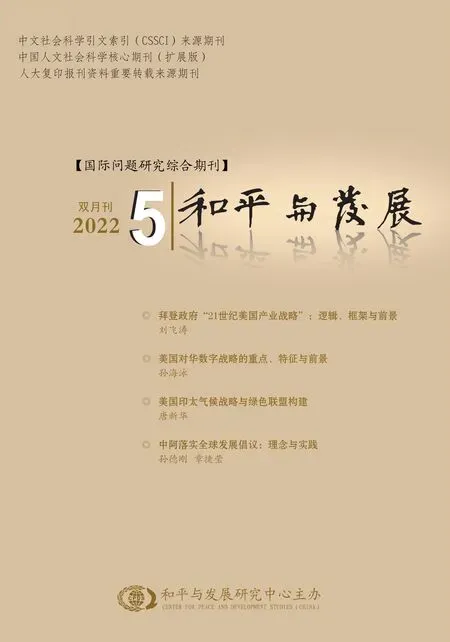Biden’s “US Industrial Strategy for the 21st Century”: Logic, Framework and Prospects
The industrial policies of the United States can be traced back to the early period of the founding of the nation, running through various historical periods of the United States in different forms. Generally speaking, they can be divided into the era of “American system”before World War II, the era of “strategic science and technology support” after the war, and the re-industrialization phase since the financial crisis. However, in the 1980s, with the rise of“Reaganomics”, which became the mainstream political and economic thought in the United States, the term of “industrial policy” became a taboo in American society and academic circles, thus making the Biden administration the first US administration to publicly advocate industrial policy and industrial strategy in the past three or four decades.
There is an economic and political logic to the Biden administration’s public advocacy and pursuit of industrial policy. In terms of economic logic, the neoliberals who supported Reaganomics believed that the best way to grow the economy was to “get the government out of the way” and maximize market efficiency to grow the economic pie, and that the benefits of rapid economic growth would eventually “trickle down” to ordinary Americans.However, in contrast to neoliberals’ expectations, the period of neo-liberalism coincided with the widening of the wealth gap in the United States. The 2008 international financial crisis further demonstrated the bankruptcy and decline of Reaganomics, and promoted the return of the economic role of the government, until the Biden administration has now put forward“Biden economics” with industrial policy as the main pillar. In terms of political logic,the Biden administration’s industrial policy is mainly driven by its economic nationalism.First, influenced by the COVID-19 pandemic, the Biden administration has established the administrative concept that economic security is national security, and generalizing the concept of national security has become the norm. Second, Biden believes that the global leadership of the United States completely depends on its economic leadership, but the predominance of the United States in global economy is facing challenges from emerging powers, especially China. Therefore, competition with China has also become an important logical basis for Biden to promote his industrial policy. In a word, Biden’s industrial policy includes economic logic to face social reality such as the polarization of the rich and poor at home and the decline of domestic manufacturing industry, and political logic to maintain America’s international dominance in response to China’s rise, which have provided impetus to and established the main direction for Biden’s contemporary “US Industrial Strategy”. At the same time, these logics have also decided that the road of industrial revitalization taken by the United States is not a temporary expedient but a medium- and long-term strategy.
From the perspective of its basic framework and content, the “US Industrial Strategy for the 21st Century” takes supply chain resilience as the central goal, and uses public investment and government procurement to work from both the supply side and the demand side to revitalize manufacturing industry and rebuild infrastructure, promote the low-carbon transformation of economic growth, and achieve the goal of social equity. In terms of its strategic design, the strategy takes strategic public investment as the main means, focuses on strategic areas where private investment is inadequate and America’s core economic and national security interests are at stake, and particularly strives to ensure that the United States remains the vanguard in industries and technologies such as semiconductors, artificial intelligence, 3D printing, telecommunications and biotechnology. From the perspective of its path design, the strategy emphasizes the following actions based on an immediate and comprehensive assessment of industrial chain and supply chain security: take import substitution of key products as the idea to make up for the emergency shortcomings of American supply chain; increase strategic investment to revitalize the US manufacturing sector under the promotion of scientific and technological innovation and starting with infrastructure reconstruction; reshape the market strategically with government procurement and trade protection as the leverage; and make the low-carbon transformation permeate all aspects of infrastructure and manufacture revitalization under the guidance of the government,pursue a clean energy strategy, and promote a “dialyzed” green transformation of the US economy.
Looking forward to the future, the path of industrial revitalization in the United States is expected to be the unanimous choice of both the Democratic and Republican parties, which will not be changed fundamentally because of the change of government or ruling party.Looking back at the history of “Reaganomics” replacing Keynesianism as the mainstream political and economic thought in the United States, we can see that the rise and fall cycle of a mainstream economic thought is roughly 30-40 years. Therefore, it is a conservative estimate that in the next 10 to 20 years, “Biden economics” and its industrial revitalization path will exist in one form or another, though not completely consistent, and have an important impact. At the same time, American economic nationalism will not recede in the short term. Great power competition will become the main “common ground” for compromise and reconciliation between the two parties, and continue to provide necessary resources and impetus for the development of the US strategic science and technology industry.
However, it should be emphasized that with the promotion of Biden’s industrial strategy,various kinds of protectionism such as trade, investment and science and technology are likely to be intensified, and the US market will continue to strengthen its closure, and the US will encounter the dilemma of decoupling from the world in the context of globalization.Moreover, the Biden administration’s hopes for a green transformation of the US economy through industrial policy may be fraught with setbacks, given the divergent stances of Democrats and Republicans on policies such as climate change and energy alternatives.
(About the author: Liu Feitao is a Senior Research Fellow and the Director at the Department for World Economy and Development, CIIS. This article was received on July 11,2022.)

